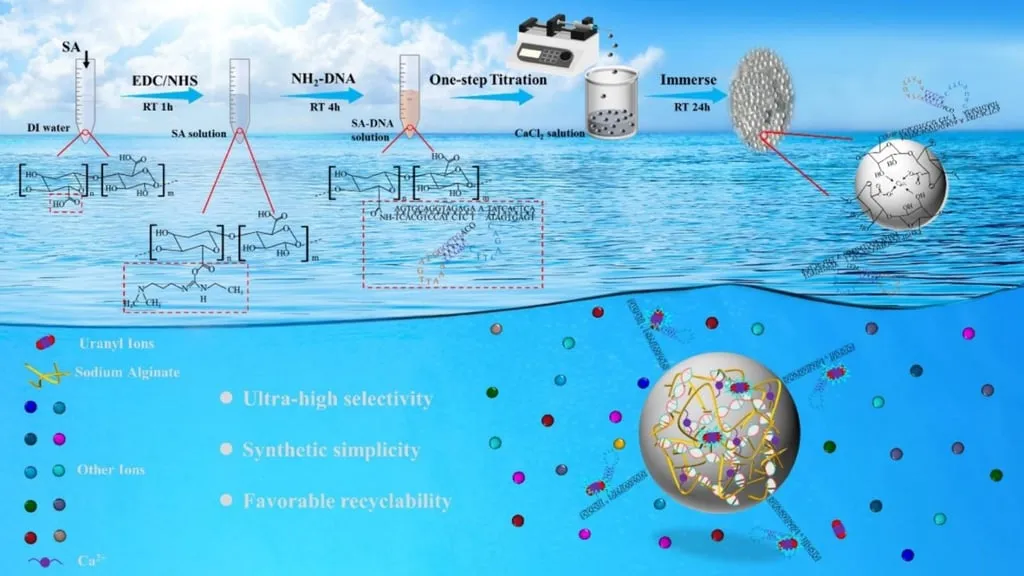In the vast, untapped expanse of the world’s oceans lies a potential game-changer for the nuclear energy industry: uranium. With terrestrial uranium resources dwindling, scientists have long been exploring the feasibility of extracting this vital nuclear fuel from seawater. Recent advancements in this field, detailed in a comprehensive review published in *He huaxue yu fangshe huaxue* (translated as *Chemistry and Applied Chemistry*), are sparking optimism about the future of sustainable nuclear energy.
The ocean contains a staggering 4.5 billion tons of uranium, more than 1,000 times the amount found in terrestrial mines. However, the complexity of the seawater system and the harsh marine environment have posed significant challenges to efficient and cost-effective extraction. “The efficiency and cost-effectiveness of uranium extraction from seawater have not yet met the requirements for industrial application,” notes Hao Li, lead author of the review and a researcher at the Institute of Nuclear Physics and Chemistry, China Academy of Engineering Physics.
Recent breakthroughs are changing this narrative. Li and his colleagues have reviewed significant progress in the design of new adsorbent materials, the development of anti-biofouling adsorbents, and innovative extraction methods like electrochemical and photocatalytic approaches. These advancements are bringing the industry closer to making uranium extraction from seawater a viable and sustainable reality.
One of the most promising areas of research is the development of new adsorbent materials. Fibrous adsorbents, widely recognized for their practicality and potential for large-scale marine tests, have shown considerable promise. Additionally, novel materials such as metal-organic frameworks (MOFs), covalent organic frameworks (COFs), hydrogen-bonded organic frameworks (HOFs), and protein-based adsorbents are pushing the boundaries of what’s possible. “These emerging materials hold great promise for the design of highly efficient uranium adsorbents,” Li explains.
However, challenges remain. The mechanical properties, formability, and economic feasibility of these novel materials need further improvement before they can be deployed on a large scale. “Due to challenges related to mechanical properties, formability, and economic feasibility, they are currently not suitable for large-scale uranium extraction from seawater,” Li acknowledges.
Another critical area of research is the development of anti-biofouling marine-adaptive materials. Biofouling, the accumulation of microorganisms, plants, algae, or small animals on wet surfaces, can significantly impede the performance of uranium adsorbents. Researchers have categorized uranium adsorbents into two types based on their anti-biofouling mechanisms: active anti-fouling (antibacterial) and passive anti-fouling (anti-adhesive). Materials that combine both types of mechanisms are showing particular promise.
Innovative extraction methods are also gaining traction. Electrochemical and photocatalytic approaches, which leverage external energy sources, can significantly improve the efficiency of uranium extraction. “If their feasibility and cost-effectiveness in marine environments can be addressed, these methods may provide alternative and innovative pathways for extracting uranium from seawater,” Li suggests.
Marine tests are crucial for validating these advancements. Chinese and Japanese studies have made significant strides in large-scale production of uranium adsorbents, the construction of marine test platforms, and the performance of uranium adsorbents in marine environments. These tests are providing valuable insights into the real-world applicability of these technologies.
The implications for the energy sector are profound. As the nuclear energy industry continues to grow, ensuring a stable supply of nuclear fuel is paramount. Uranium extraction from seawater could provide a sustainable and virtually limitless source of this vital resource. “The ocean contains a staggering 4.5 billion tons of uranium, more than 1,000 times the amount found in terrestrial mines,” Li emphasizes.
As research continues to advance, the dream of harnessing the ocean’s vast uranium resources is becoming increasingly attainable. With continued innovation and investment, uranium extraction from seawater could soon become a cornerstone of the nuclear energy industry, ensuring a sustainable and secure energy future for generations to come.

